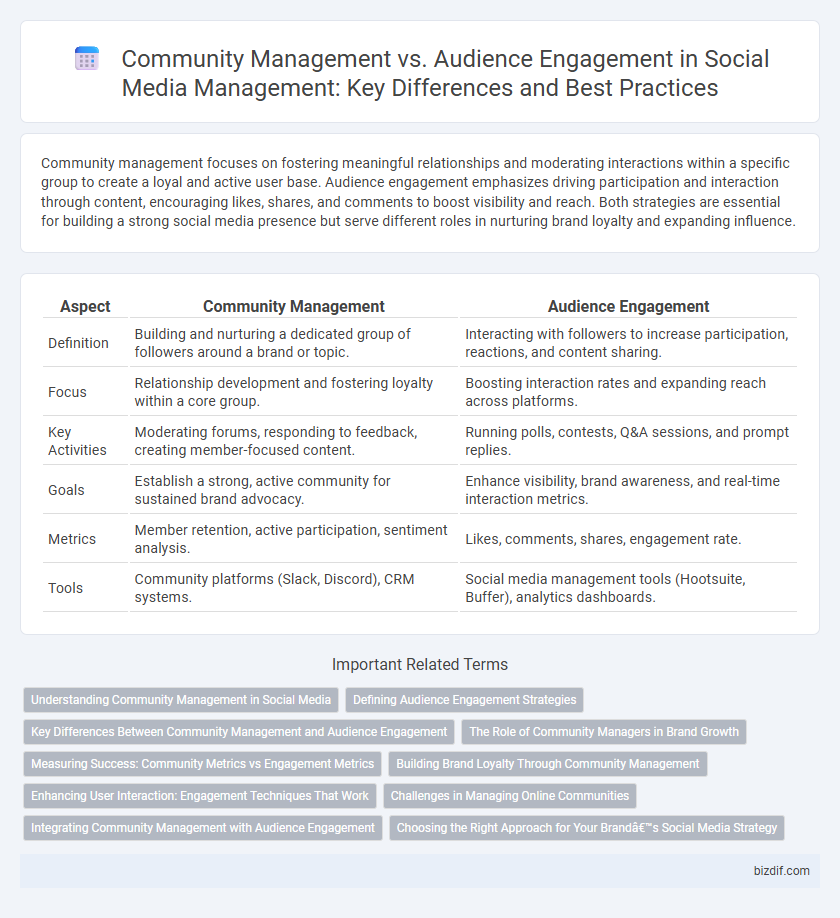Community management focuses on fostering meaningful relationships and moderating interactions within a specific group to create a loyal and active user base. Audience engagement emphasizes driving participation and interaction through content, encouraging likes, shares, and comments to boost visibility and reach. Both strategies are essential for building a strong social media presence but serve different roles in nurturing brand loyalty and expanding influence.
Table of Comparison
| Aspect | Community Management | Audience Engagement |
|---|---|---|
| Definition | Building and nurturing a dedicated group of followers around a brand or topic. | Interacting with followers to increase participation, reactions, and content sharing. |
| Focus | Relationship development and fostering loyalty within a core group. | Boosting interaction rates and expanding reach across platforms. |
| Key Activities | Moderating forums, responding to feedback, creating member-focused content. | Running polls, contests, Q&A sessions, and prompt replies. |
| Goals | Establish a strong, active community for sustained brand advocacy. | Enhance visibility, brand awareness, and real-time interaction metrics. |
| Metrics | Member retention, active participation, sentiment analysis. | Likes, comments, shares, engagement rate. |
| Tools | Community platforms (Slack, Discord), CRM systems. | Social media management tools (Hootsuite, Buffer), analytics dashboards. |
Understanding Community Management in Social Media
Community management in social media involves actively building and nurturing relationships with followers by facilitating meaningful interactions, responding to comments, and addressing concerns to foster loyalty. It requires understanding the unique needs and behaviors of the community to create a supportive and inclusive environment that encourages ongoing participation. Effective community management directly impacts brand reputation and drives long-term customer retention by transforming passive audiences into engaged advocates.
Defining Audience Engagement Strategies
Defining audience engagement strategies involves creating targeted content and interactive experiences that foster meaningful connections between brands and their followers. Community management emphasizes monitoring conversations, responding promptly, and nurturing relationships within a social media community to build trust and loyalty. Effective audience engagement integrates personalized messaging and analytics-driven insights to enhance user participation and drive brand advocacy.
Key Differences Between Community Management and Audience Engagement
Community management involves fostering relationships, moderating discussions, and creating a supportive environment within a brand's social media spaces, emphasizing two-way communication and member interaction. Audience engagement focuses on driving interactions such as likes, shares, and comments to increase visibility and brand awareness, often through content that encourages participation. The key difference lies in community management's deeper relational approach versus audience engagement's broader emphasis on activity metrics and reach.
The Role of Community Managers in Brand Growth
Community managers play a critical role in brand growth by fostering authentic relationships and nurturing a loyal customer base through proactive community management. They facilitate meaningful conversations, resolve customer issues promptly, and create a sense of belonging that drives long-term engagement and advocacy. Unlike general audience engagement, community management emphasizes personalized interaction, turning passive followers into active brand ambassadors and enhancing overall brand reputation.
Measuring Success: Community Metrics vs Engagement Metrics
Measuring success in social media management involves analyzing distinct metrics for community management and audience engagement. Community management success is tracked through community metrics such as member growth rate, active participation levels, and sentiment analysis within groups or forums. Audience engagement metrics focus on likes, shares, comments, click-through rates, and overall interaction rates that reflect content resonance and user involvement.
Building Brand Loyalty Through Community Management
Community management fosters brand loyalty by actively nurturing relationships and creating meaningful interactions within a dedicated group of followers. Unlike general audience engagement, which may involve broad content distribution and passive interaction, community management emphasizes personalized communication and consistent support to strengthen trust and advocacy. Investing in community management leads to deeper emotional connections and long-term customer commitment, driving sustained brand growth.
Enhancing User Interaction: Engagement Techniques That Work
Community management involves actively moderating discussions and fostering a supportive environment, while audience engagement focuses on creating compelling content that encourages user interaction. Techniques such as personalized responses, interactive polls, and timely feedback significantly boost user participation and loyalty. Leveraging analytics to tailor engagement strategies ensures sustained growth and meaningful connections within social media platforms.
Challenges in Managing Online Communities
Managing online communities involves navigating challenges such as moderating diverse user interactions while maintaining a positive environment and addressing conflicts promptly to prevent escalation. Community managers must balance enforcing guidelines with encouraging authentic conversations, often confronting issues like spam, trolling, and misinformation. Effective audience engagement requires continuous monitoring and adapting strategies to foster meaningful connections without compromising community integrity.
Integrating Community Management with Audience Engagement
Effective social media management integrates community management with audience engagement to foster authentic interactions and build loyalty. By combining proactive moderation, personalized responses, and real-time feedback, brands enhance user experience and drive meaningful conversations. Leveraging analytics tools to monitor community sentiment and engagement metrics optimizes strategies for sustained growth and brand advocacy.
Choosing the Right Approach for Your Brand’s Social Media Strategy
Community management centers on fostering a loyal group of followers by actively responding to comments, moderating discussions, and building relationships to create a sense of belonging. Audience engagement emphasizes generating interactions such as likes, shares, and comments to boost visibility and attract new followers through compelling content and calls to action. Selecting the right approach depends on your brand's goals, whether prioritizing long-term community loyalty or short-term engagement metrics to enhance social media presence.
Community management vs Audience engagement Infographic

 bizdif.com
bizdif.com